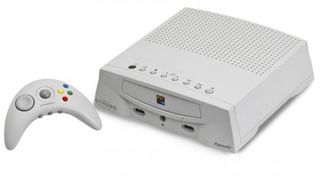When Apple drops the ball: the gear that flopped
Coulda, woulda, shoulda
These days you can do it all in software, but back in the day this was bleeding-edge. There are probably only a small number of Twentieth Anniversary Macs in the UK. Of which, at a guess, the bulk are in glass cases. It was an all-in-one unit (if you discount the large external subwoofer) with a vertically mounted CD-ROM, built-in TV tuner, built-in radio, 2GB drive, an active matrix LCD display, but only 10in deep. It was the first desktop PC to use an LCD, and given a long enough ADB cable for the keyboard, you could actually wall-mount it. It was massively over-priced though (over $7k), offered a trackpad instead of a mouse, and the screen was only 12.1 inches.
It suffered by being ahead of its time - by about 7 years. It was the proto-iMac G5, and another example of the internet now fixing problems that used to be dealt with by splashing the cash on hardware. Macs don't need TV and radio receiver hardware now because we've got YouTube and iPlayer. If only large LCDs had been available, it could have been the first media centre PC.
Innovation

A history of Apple isn't just a history of Mac hardware. Apple attempts to innovate in pretty much every arena it enters, with hardware near-misses, cul-desacs, and failures aplenty. Any list of purported Apple missteps will include the Newton narrative: Steve Jobs hated John Sculley's baby, styli were evil, the handwriting recognition sucked, Apple was spread too thinly and engineers were better deployed elsewhere, so Jobs axed the Newton.
But it wasn't just a PDA; the eMate 300 was a Newton with a keyboard. Aimed at the education market and priced accordingly ($800), it was a pre-cursor to many future technologies. It was a tough little thing: entirely solid state, it had a practically waterproof keyboard, expandable memory, and shipped with basic office software. Oh, if only it had been wireless! Given the cost corollaries of Moore's law, the eMate 300 was clearly the steampunk embodiment of a One Laptop Per Child device.
Apple has a great track record for opening up new markets. Did you know that Apple produced the first consumer digital camera? Well, actually it was the second - but it was the first mass-market one. The QuickTake 100 was the pinhole camera of digital world: it could only take 24-bit PICT files, with a maximum resolution of 640x480, and then only eight at a time. But it was so freeing; it cut out the 'snap, develop, scan' process to which we were inured.
For a design conference in May 1994, our correspondent managed to whip up the proceedings notes as PDFs with pictures of the speakers, in under an hour. For the delegates, this was pure Arthur C Clarke magic. So what was the reason it failed? It awoke the slumbering camera incumbents to the fact they could no longer delay the move to digital.
Some Apple kit had a really short shelf life: see the Apple Network Server (ANS). Not many people have even seen - let alone used - one. The ANS was a PowerPC-based box designed to run AIX, and was Apple's confused attempt to break into the Enterprise Server market. In essence, it was a hugely expandable PowerMac 9500, with the ROMs removed, stuffed into a tumble-dryer sized cabinet.
Get daily insight, inspiration and deals in your inbox
Get the hottest deals available in your inbox plus news, reviews, opinion, analysis and more from the TechRadar team.
It was designed to not run Mac OS, and very quickly wrote its own death sentence. At $19,000, it remains Apple's most expensive catalogue-priced machine. On second thoughts, it does manage to succeed as the best tech bargain ever: one recently sold on eBay for $1.56 (shipping $120).

Apple actually made a games console. Well, they designed it, and Bandai made them. But they only made about forty thousand. The Pippin was also Apple's attempt to create a network computer (NC).
